The following Bar Diagram dpeicts figures for some agricultural imports from January-May, 2008. Answer (as closely as possible) the questions using the date provided here
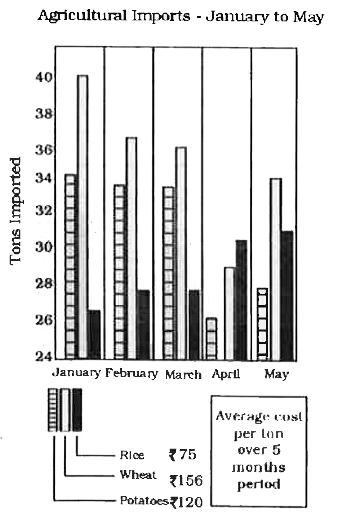
What is the average cost of potato import in February and March?
(a) Rs 3,960
(b) Rs 5,960
(c) Rs 1,280
(d) Rs 4,440
The correct Answer is:A
Step by step video, text & image solution for The following Bar Diagram dpeicts figures for some agricultural imports from January-May, 2008. Answer (as closely as possible) the questions using the date provided here What is the average cost of potato import in February and March? by Maths experts to help you in doubts & scoring excellent marks in Class 14 exams.
Updated on:21/07/2023Topper's Solved these Questions
- STATISTICS AND DATA INTERPRETATIONBOOK - KIRAN PUBLICATIONCHAPTER - STATISTICS AND DATA INTERPRETATIONEXERCISE - TYPE-V
38 Videos
- STATISTICS AND DATA INTERPRETATIONBOOK - KIRAN PUBLICATIONCHAPTER - STATISTICS AND DATA INTERPRETATIONEXERCISE - TYPE-VI
86 Videos
- STATISTICS AND DATA INTERPRETATIONBOOK - KIRAN PUBLICATIONCHAPTER - STATISTICS AND DATA INTERPRETATIONEXERCISE - TYPE-III
39 Videos
- SIMPLIFICATIONBOOK - KIRAN PUBLICATIONCHAPTER - SIMPLIFICATIONEXERCISE - TEST YOURSELF
25 Videos
- TIME AND DISTANCEBOOK - KIRAN PUBLICATIONCHAPTER - TIME AND DISTANCEEXERCISE - Type -XI
74 Videos
Similar Questions
Read the following bar graph and answer the questions for (Q.No−30→32)What is the income of the company between January and March? What is the profit percentage in the month of April?What is the ratio of the income to expenditure from January to June?
View SolutionThe bar graph shows the production of the different departments of a company. Study the diagram and answer the following questions.

If the average cost a unit produced by department C is Rs 250 then what is the cost of the production (in Rs) of all units produced by department C?
View Solution
Knowledge Check
The following Bar Diagram dpeicts figures for some agricultural imports from January-May, 2008. Answer (as closely as possible) the questions using the date provided here
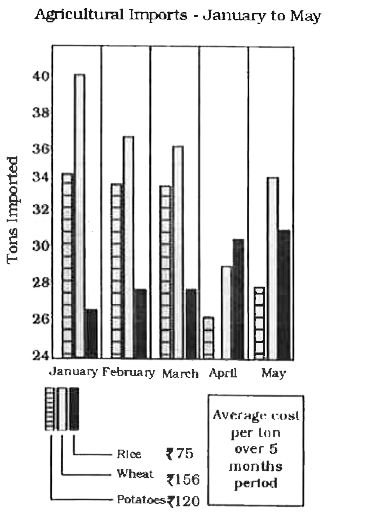
What was the total cost (in Rs) of wheat import in March?ARs 3,212BRs 5,616CRs 7,042DRs 2,224The following bar diagram, represents the use of different modes of travel to school by students in a certain locality of the town. Study the graph and answer the questions.
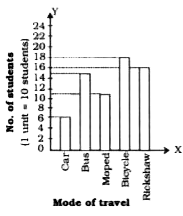
What is the percentage of students using Bus from that locality ?A221433%B1823%C22811%D0.22The following bar-diagram shows total number of males and females in five different organisations. Study it carefully to answer the questions.
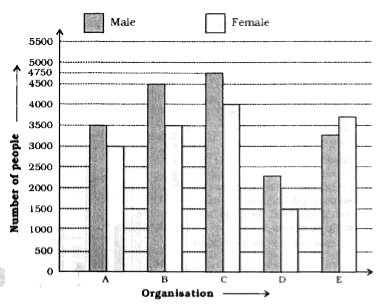
What is the ratio of average number of females from the organisations A, B and C to the average number of males from the organisations C, D and E?A42:41B41:42C40:41D41:40
Study the following bar graph showing the percentage of children who can read at first grade level, grouped by their grade level in an Indian state.
For example, in 2008, 82% of the children from Standard 3 could read a text from Standard 1. Now answer the following question based on this graph.
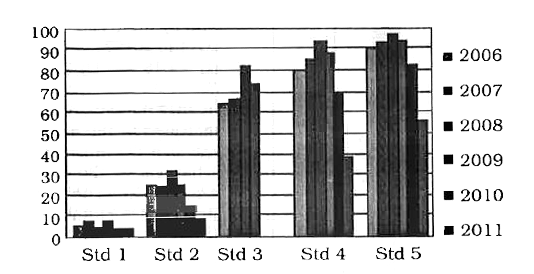
In the year 2010, what is the approximate value of average of all Std 1, 2, 3, 4, 5 children who could read the Std 1 text?
View SolutionA passage is given with five questions following it. Read the passage carefully and select the best answer to each question out of the given four alternatives.
The rural economy is an important segment of the ecosystem and accounts for around 70 percent of employment and 50 percent of GDP with agriculture being the main driver followed by services and manufacturing. It is largely unorganized and hence those working in rural India or consuming in this economy are a different category of economic agents driven by different factors. The economy is quite complex in so far as the fact that cash dominates in terms of transactions and while there has been some intrusion of the use of credit (kisan) and debit cards and ATMs, dependence on technology driven payments system is limited. This has hence also become a haven for routing black money both in terms of seeking tax exemptions by channeling funds, to convert to legitimate funds. But a lot of black money gets into land and ' apparent rural activity ' . Now consider some aspects of this economy and the cash conundrum. Almost all transactions in the mandis (there are above 7,000 organized ones and over double the number that is unorganized), are based on cash as it is easy to use. The farmers prefer to receive cash and while some do take in cheques there is a sense of doubt if the counter party is unknown. Hence one reason why electronic mandis is a good idea is that payments can also be made through the electronic mode as all transactions would be e-enabled. The recent demonetization has caused significant distortions as farmers are unable to sell their goods. This has happened just when we are in middle of the kharif harvest which involves rice, soybean, cotton, maize, sugarcane, bajra, besides fruits and vegetables which are all year through. The second issue for Indian agriculture is the rabi season which has begun where farmers start sowing their seeds. The issue here is less serious as a large part is backed by credit where the prevalent cash crunch may not matter. It would only be at the margin that farmers may be impacted, and hence the pain here would be secondary.
What has become a haven for routing black money in India?
View SolutionA passage is given with five questions following it. Read the passage carefully and select the best answer to each question out of the given four alternatives.
The rural economy is an important segment of the ecosystem and accounts for around 70 percent of employment and 50 percent of GDP with agriculture being the main driver followed by services and manufacturing. It is largely unorganized and hence those working in rural India or consuming in this economy are a different category of economic agents driven by different factors. The economy is quite complex in so far as the fact that cash dominates in terms of transactions and while there has been some intrusion of the use of credit (kisan) and debit cards and ATMs, dependence on technology driven payments system is limited. This has hence also become a haven for routing black money both in terms of seeking tax exemptions by channeling funds, to convert to legitimate funds. But a lot of black money gets into land and .apparent rural activity.. Now consider some aspects of this economy and the cash conundrum. Almost all transactions in the mandis (there are above 7,000 organized ones and over double the number that is unorganized), are based on cash as it is easy to use. The farmers prefer to receive cash and while some do take in cheques there is a sense of doubt if the counter party is unknown. Hence one reason why electronic mandis is a good idea is that payments can also be made through the electronic mode as all transactions would be e-enabled. The recent demonetization has caused significant distortions as farmers are unable to sell their goods. This has happened just when we are in middle of the kharif harvest which involves rice, soybean, cotton, maize, sugarcane, bajra, besides fruits and vegetables which are all year through. The second issue for Indian agriculture is the rabi season which has begun where farmers start sowing their seeds. The issue here is less serious as a large part is backed by credit where the prevalent cash crunch may not matter. It would only be at the margin that farmers may be impacted, and hence the pain here would be secondary.
What has become a haven for routing black money in India?
View SolutionA passage is given with five questions following it. Read the passage carefully and select the best answer to each question out of the given four alternatives.
The rural economy is an important segment of the ecosystem and accounts for around 70 percent of employment and 50 percent of GDP with agriculture being the main driver followed by services and manufacturing. It is largely unorganized and hence those working in rural India or consuming in this economy are a different category of economic agents driven by different factors. The economy is quite complex in so far as the fact that cash dominates in terms of transactions and while there has been some intrusion of the use of credit (kisan) and debit cards and ATMs, dependence on technology driven payments system is limited. This has hence also become a haven for routing black money both in terms of seeking tax exemptions by channeling funds, to convert to legitimate funds. But a lot of black money gets into land and ' apparent rural activity ' . Now consider some aspects of this economy and the cash conundrum. Almost all transactions in the mandis (there are above 7,000 organized ones and over double the number that is unorganized), are based on cash as it is easy to use. The farmers prefer to receive cash and while some do take in cheques there is a sense of doubt if the counter party is unknown. Hence one reason why electronic mandis is a good idea is that payments can also be made through the electronic mode as all transactions would be e-enabled. The recent demonetization has caused significant distortions as farmers are unable to sell their goods. This has happened just when we are in middle of the kharif harvest which involves rice, soybean, cotton, maize, sugarcane, bajra, besides fruits and vegetables which are all year through. The second issue for Indian agriculture is the rabi season which has begun where farmers start sowing their seeds. The issue here is less serious as a large part is backed by credit where the prevalent cash crunch may not matter. It would only be at the margin that farmers may be impacted, and hence the pain here would be secondary.
According to the passage, which among the following is the major contributor to India's GDP growth?
View SolutionA passage is given with five questions following it. Read the passage carefully and select the best answer to each question out of the given four alternatives.
The rural economy is an important segment of the ecosystem and accounts for around 70 percent of employment and 50 percent of GDP with agriculture being the main driver followed by services and manufacturing. It is largely unorganized and hence those working in rural India or consuming in this economy are a different category of economic agents driven by different factors. The economy is quite complex in so far as the fact that cash dominates in terms of transactions and while there has been some intrusion of the use of credit (kisan) and debit cards and ATMs, dependence on technology driven payments system is limited. This has hence also become a haven for routing black money both in terms of seeking tax exemptions by channeling funds, to convert to legitimate funds. But a lot of black money gets into land and ' apparent rural activity ' . Now consider some aspects of this economy and the cash conundrum. Almost all transactions in the mandis (there are above 7,000 organized ones and over double the number that is unorganized), are based on cash as it is easy to use. The farmers prefer to receive cash and while some do take in cheques there is a sense of doubt if the counter party is unknown. Hence one reason why electronic mandis is a good idea is that payments can also be made through the electronic mode as all transactions would be e-enabled. The recent demonetization has caused significant distortions as farmers are unable to sell their goods. This has happened just when we are in middle of the kharif harvest which involves rice, soybean, cotton, maize, sugarcane, bajra, besides fruits and vegetables which are all year through. The second issue for Indian agriculture is the rabi season which has begun where farmers start sowing their seeds. The issue here is less serious as a large part is backed by credit where the prevalent cash crunch may not matter. It would only be at the margin that farmers may be impacted, and hence the pain here would be secondary.
Which among the following is not a kharif crop?
View Solution
